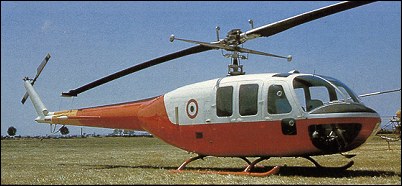
| Agusta/Bell AB.102 1970 |  |
 |

| Agusta/Bell AB.102 1970 |  |
 |
|
Agusta had gained much experience from their licenced building of the Agusta/Bell-47. The Agusta design team went to work on expanding the already successful Bell designs. Using an old Bell-47, Agusta designed a new fuselage around the old helicopter that increased its capacity to eight passengers. The first prototype flew on 3 February 1959 and was seen in military colours at the 1959 Paris Airshow. Designed to fill the growing civilian helicopter market, the A.102 sold to several Italian commercial companies. The helicopter was powered by a Pratt & Whitney R-1340 piston engine developing 600hp, had a range of 400km and a cruising speed of 160kph. P.Allen "The Helicopter", 1996 
From an old Bell Model 48 sent to Italy in 1956, Agusta developed a helicopter using the same mechanical components, powerplant and dimensions, but an entirely new fuselage. Behind the two pilot seats, there was room for two-three passengers plus a bench seat for another four-five in the fuselage, which was over 2.7m wide. The original quadricycle landing gear was replaced by skids. The prototype of the A.102 flew on 3 February 1959, and was displayed in military colours at that year's Paris Air Show. But Agusta also intended the A.102 for the civil market, which was growing in Italy, and indeed Elivie, the company which was already running flights with AB-47J helicopters between Naples and the islands, took delivery of a couple of A.102s in spring 1961, to operate a regular service between the center of Turin and Milan airports. The availability of new turbine-powered helicopters, however, soon rendered the A.102 obsolete. G.Apostolo "The Illustrated Encyclopedia of Helicopters", 1984
Under the designation Agusta-Bell AB 102, Agusta designed a 7/9-seat passenger transport helicopter which was intended for both civil and military applications. The name Agusta-Bell was applied because Agusta used in this aircraft a Bell two-blade main rotor system complete with stabilising bar below and at right angles to the rotor blades. In other respects it was of conventional pod and boom configuration, the tail pylon mounting a two-blade anti-torque rotor. Tubular skid landing gear was provided, and powerplant consisted of a Pratt & Whitney R-1340 radial engine mounted in the aft cabin. The forward cabin was furnished to accommodate a pilot and 7/9 passengers, but alternative configurations included an ambulance layout with four stretchers and seating for a medical attendant, and a combined passenger cargo interior. Up to 880kg of freight could be carried internally in an all-cargo role. An electric hoist was also available optionally for use in SAR operations. Very limited production included two helicopters used for passenger services between Milan and Turin. D.Donald "The Complete Encyclopedia of World Aircraft", 1997
|